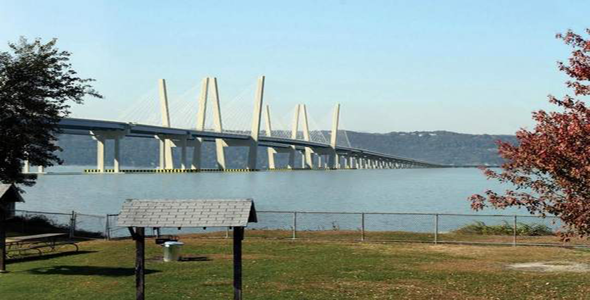LoHud May 7, 2013
Written by, Khurram Saeed and Theresa Juva-Brown
Construction of the new Tappan Zee Bridge will create the equivalent of 7,700 full-time jobs and pour $2 billion in disposable personal income into the region in the next five years, according to a new state-commissioned economic study.
“The timing is just incredible — you are talking about putting money into the pockets of working people who for the past three or four years, as a group, had major difficulties,” said Al Samuels, president of the Rockland Business Association. “This is a tremendous asset for folks to come out of the recession.”
Samuels added that when people have more money to spend, local governments also benefit.
“The sales-tax revenue that will accrue to the county and local municipalities is also a big plus,” he said. “It’s good on so many fronts.”
The project is expected to create 38,644 direct and indirect jobs as reported in “job-years,” a standard employment measure used by government on projects. A job-year is one job held for one year. So a trucck driver who works on this project for the next five years will have worked five job-years.
Each year, the project will generate roughly 2,600 construction jobs, 500 office and administrative positions, and some 700 sales and transportation-related jobs, according to the analysis conducted by the state Department of Labor and Empire State Development.
The study predicted employment spikes in management, food services and finance. Additionally, it found that a large construction project like the Tappan Zee “will spur secondary labor demand in retail trade, leisure and hospitality, and population-dependent industries such as health care.”
The study noted that additional analysis was required to figure out specific occupations, when they will be created, and how long they will be needed.
Farrokh Hormozi, an economics professor at Pace University in White Plains, predicted the actual economic impacts of the $3.9 billion five-year project will begin to be felt within a year or so.
“It’s going to boost the economy of the region,” Hormozi said. “This is the type of (project) that cannot be outsourced. … You have to hire local people. Wages and salaries will be made locally. And the impact will be felt locally.”
He said there would be a multiplier effect as workers spend their earnings in their communities. Also, local businesses may directly benefit by providing materials and services for the project or indirectly by seeing their sales increase due to increased demand. That will create income for others, he said.
“These workers, they have to eat, they have to relax and they have go shopping,” Hormozi said.
The job figures were based on $3.9 billion of spending.
“This project is one of the biggest opportunities for us to work collaboratively with local business and contractors on placing New Yorkers in new and exciting jobs,” state Labor Commissioner Peter Rivera said in a statement, adding the agency was prepared to match workers to openings and businesses.
The overwhelming majority of construction and trade jobs will go to local unions, which are covered by a project labor agreement.
But Tappan Zee Constructors, the joint venture that will design and build the new bridge, has already begun accepting résumés from job seekers on its website, http://www.tappanzeeconstructors.com/. The state Labor Department will continue to host career fairs and training to recruit workers.
“The information developed by the state Department of Labor and Empire State Development maps out in new, greater details the jobs that building this new bridge will create throughout the region,” said Thomas Madison, executive director of the New York State Thruway Authority, whose agency requested the study.
Construction of the replacement bridge will generate $3.2 billion in gross domestic product, the study said. The project will create $5.6 billion in total value of all goods produced and $3.7 billion in total personal income.


